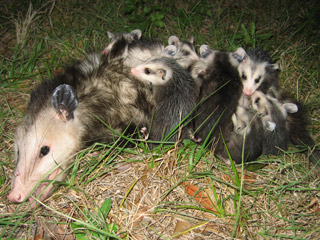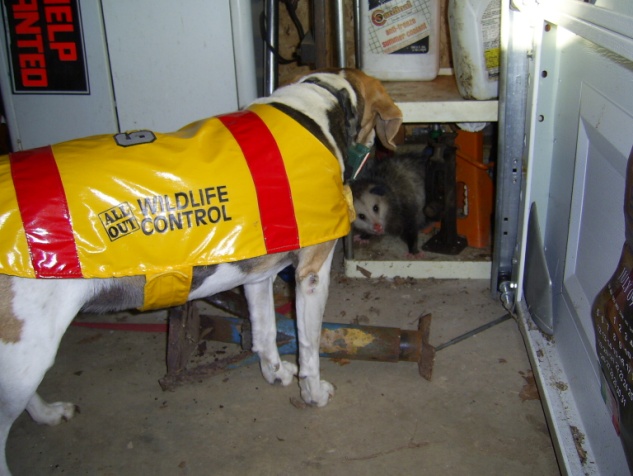Opossums

Prepared by the National Wildlife Control Training Program. Research-based, wildlife control information.
Objectives
- Describe the behavior of opossums.
- Communicate the options for damage management to clients.
- Describe the risks to animal health that opossums pose.
Species Overview
Conflicts
Legal Status
Laws and regulations that protect opossums vary among states. In most states they are furbearers, with open seasons for hunting or trapping opossums. Check with your state and local authorities for options in dealing with opossums.
Identification
Opossums (Figure 1) are the only marsupials (pouched mammals such as kangaroos and wombats) in North America. The color of their fur ranges from snow-white to jet-black. The underfur is dense with sparse guard hairs. Its tail is rat-like, hairless, and slightly less than half the total length of the opossum. The tail is moderately prehensile.
Physical Description
Opossums are about the same size as house cats, but can grow to a length of 40 inches. In northern climates, however, tail length may be shorter due to frostbite. Opossums may weigh up to 14 pounds, but the average weight is 4 to 12 pounds, with males generally larger than females. The face is long and pointed with a skull that is usually 3 to 4 inches long and holds 50 teeth, more than any other mammal in North America.
Health and Safety Concerns
Opossums often harbor parasites such as fleas and ticks, and are more resistant to rabies than any other mammal, although they are not completely immune.
General Biology, Reproduction, and Behavior
Reproduction
Opossums are solitary, except when mating or caring for young. Female opossums usually raise 2 litters per year. Young are born blind, hairless, and helpless 13 days after mating. When young are born, they find their way into the female’s pouch, where they each attach to one of 13 teats. About 23 young are born, but only those that attach to a teat survive. The rest quickly perish. The average litter size is 7 to 8. They remain in the pouch for 7 to 8 weeks, and are not weaned until 96 to 108 days after birth. Most young die during their first year, and opossums may live 2 to 3 years in the wild.
Nesting/Denning Cover
Opossums do not dig their own burrows, but will use burrows abandoned by other animals. Other den sites include tree cavities, brush piles, rock crevices, and abandoned squirrel nests. Opossums sometimes den under homes, in attics, and in garages where they may make messy nests.
Behavior
Opossums are usually solitary and nomadic, with a home range of 10 to 50 acres. They have a top running speed of 3.5 miles per hour, and escape predators by entering burrows, climbing trees, or swimming. When threatened, opossums may bare their teeth, growl, hiss, bite, screech, and exude a yellow-green fluid from the anal glands that smells mildly like skunk musk. An opossum may “play dead” by rolling on its back and going limp, sometimes with the tongue hanging out of its mouth.
Opossums do not hibernate. During very cold weather, they enter dens for short periods until temperatures warm. Although primarily nocturnal, they may forage during the day, especially in cold weather.
Habitat
Opossum live in a wide range of habitats, from arid to moist, wooded to open fields. Opossums prefer environments near streams or swamps. They take shelter in burrows of other animals, tree cavities, brush piles, and other cover.
Food Habits
Opossums are opportunistic omnivores. They eat animals and plants, including insects, worms, snakes, lizards, mice, rats, grasses, fruits, and vegetables. Opossums may feed at compost piles, garbage cans, or pet food dishes. Opossums may be considered beneficial because they feed on insects, mice, and rats. They readily take carrion, and are often hit by vehicles while feeding on road-killed animals.
Voice, Sounds, Tracks, and Signs
When frightened, opossums hiss, growl, screech, and bare their teeth, depending on the level of threat that they perceive. Males and females signal each other with a clicking sound during the breeding season.
Damage Identification
Signs of opossum damage are often confused with those of skunks or raccoons. Often, seeing an opossum is the only way to confirm its presence.
Damage to Landscapes
Opossums consume garden produce and tree fruits. They may also feed on food scraps in compost piles.
Damage to Crops and Livestock
Opossums generally do not cause crop losses. Also, they typically avoid pets and livestock. Opossums may prey on chickens, ducks, pigeons, and eggs. Opossum can carry the microorganism that causes Equine Protozoan Myeloencephalitis (EPM), which kills horses. The protozoan is shed in feces, so an opossum that is denning or feeding in stable areas may contaminate feed and water used for horses.
Damage to Structures
Opossums may enter trailer houses and climb into insulation under the floor. They often are encountered moving about the ductwork of mobile homes. Opossums are not destructive or strong, so typically they enter areas where an opening already exists. They commonly enter living quarters through large gaps around pipes and drains under sinks. In contrast, raccoons are powerful and often create openings.
Damage Prevention and Control Methods
Habitat Modification
Remove pet food, fruits, and other foods that might attract opossums. Opossums eat birdseed, so hang a bird feeder on a wire between trees, or on a baffled pole to prevent raiding. Reduce the amount of seed that falls to the ground by using one type of seed per feeder and using feeders that recapture fallen seed.
Secure lids on trash cans and enclose compost piles in bins. Only place non-food plant materials (e.g., leaves and grass clippings) in compost piles to avoid attracting opossums, skunks, raccoons, and other scavengers.
Exclusion
Install sunken perimeter fences around crawl spaces below decks or buildings. Cover structure openings with hardware cloth. Use electric fences or porcupine-wire to prevent climbing. Install one-way doors (6- x 6-inch) to evict opossums from buildings. Once they leave a structure, they will not be able to re-enter.
Frightening Devices
Frightening devices are not practical for dispersing opossums. However, dogs may discourage opossums from visiting an area.
Repellents
No repellents are registered for opossums.
Toxicants
No toxicants are registered for opossums.
Shooting
A .22-caliber rifle or pistol, or a shotgun with No. 6 shot in the hands of an experienced shooter, is effective for killing opossums. Local or state regulations may limit shooting in urban areas.
Trapping
Opossums are relatively unwary and easy to trap. In suburban areas, cage traps (e.g., 10 x 12 x 32 single door, or 7 x 7 x 24 double-door) are preferred for capturing opossums. Use cat food, fruit, or marshmallows as bait. Body-gripping traps (Nos. 160 or 220) and foothold traps (Nos. 1 or 1½ padded jaw trap) also can be used to capture an opossum in rural areas where pets are not at risk.
Other Methods
Opossums are easy to corner in enclosed areas and can be captured with catch poles, cat-graspers or hand nets. Do not grasp an opossum by the tail. You can hand-capture an opossum while wearing gloves by grasping the back of the neck and using the other hand to support the back. Opossums usually will relax when restrained. Trained dogs can be used to locate opossums (Figure 2).

Relocation
Relocation of opossums is appropriate for rescues. Release the opossum into cover away from roads and where people live.
Translocation
If translocation of opossums is legal in your state, transport them at least 5 miles away from the capture site, and release them into suitable habitat.
Euthanasia
Carbon dioxide gas is the most appropriate technique to euthanize opossums. Opossums also can be humanely killed with a gunshot to the head, if legal and safe in your area.
Web Resources
Opossum, NWCO, wildlife control, wildlife damage management